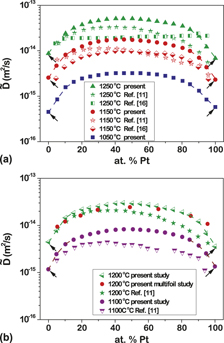Crossref Citations
This article has been cited by the following publications. This list is generated based on data provided by
Crossref.
Tsai, K.-Y.
Tsai, M.-H.
and
Yeh, J.-W.
2013.
Sluggish diffusion in Co–Cr–Fe–Mn–Ni high-entropy alloys.
Acta Materialia,
Vol. 61,
Issue. 13,
p.
4887.
Roy, Soumitra
and
Paul, Aloke
2013.
Diffusion in tungsten silicides.
Intermetallics,
Vol. 37,
Issue. ,
p.
83.
Divya, V.D.
Ramamurty, U.
and
Paul, A.
2013.
Interdiffusion and solid solution strengthening in Ni–Co–Pt and Ni–Co–Fe ternary systems.
Philosophical Magazine,
Vol. 93,
Issue. 17,
p.
2190.
Baheti, Varun A.
Ravi, Raju
and
Paul, Aloke
2013.
Interdiffusion study in the Pd–Pt system.
Journal of Materials Science: Materials in Electronics,
Vol. 24,
Issue. 8,
p.
2833.
Paul, Aloke
2013.
A pseudobinary approach to study interdiffusion and the Kirkendall effect in multicomponent systems.
Philosophical Magazine,
Vol. 93,
Issue. 18,
p.
2297.
Santra, Sangeeta
Dong, Hongqun
Laurila, Tomi
and
Paul, Aloke
2014.
Role of different factors affecting interdiffusion in Cu(Ga) and Cu(Si) solid solutions.
Proceedings of the Royal Society A: Mathematical, Physical and Engineering Sciences,
Vol. 470,
Issue. 2161,
p.
20130464.
Roy, Soumitra
Prasad, Soma
Divinski, Sergiy V.
and
Paul, Aloke
2014.
Diffusion pattern in MSi2and M5Si3silicides in group VB (M = V, Nb, Ta) and VIB (M = Mo, W) refractory metal-silicon systems.
Philosophical Magazine,
Vol. 94,
Issue. 14,
p.
1508.
Paul, Aloke
Laurila, Tomi
Vuorinen, Vesa
and
Divinski, Sergiy V.
2014.
Thermodynamics, Diffusion and the Kirkendall Effect in Solids.
p.
239.
Ahmed, T.
Belova, I. V.
Evteev, A. V.
Levchenko, E. V.
and
Murch, G. E.
2015.
Comparison of the Sauer-Freise and Hall Methods for Obtaining Interdiffusion Coefficients in Binary Alloys.
Journal of Phase Equilibria and Diffusion,
Vol. 36,
Issue. 4,
p.
366.
Paul, T.R.
Belova, I.V.
Levchenko, E.V.
Evteev, A.V.
and
Murch, G.E.
2015.
Determining a Tracer Diffusivity by way of the Darken-Manning Equation for Interdiffusion in Binary Alloy Systems.
Diffusion Foundations,
Vol. 4,
Issue. ,
p.
25.
Kiruthika, P.
Makineni, S.K.
Srivastava, C.
Chattopadhyay, K.
and
Paul, A.
2016.
Growth mechanism of the interdiffusion zone between platinum modified bond coats and single crystal superalloys.
Acta Materialia,
Vol. 105,
Issue. ,
p.
438.
Baheti, Varun A.
Islam, Sarfaraj
Kumar, Praveen
Ravi, Raju
Narayanan, Ramesh
Hongqun, Dong
Vuorinen, Vesa
Laurila, Tomi
and
Paul, Aloke
2016.
Effect of Ni content on the diffusion-controlled growth of the product phases in the Cu(Ni)–Sn system.
Philosophical Magazine,
Vol. 96,
Issue. 1,
p.
15.
Seo, Okkyun
Oh, Se An
Lee, Ji Yeon
Ha, Sung Soo
Kim, Jae Myung
Choi, Jung Won
Kim, Jin-Woo
Kang, Hyon Chol
and
Noh, Do Young
2016.
Controlling the alloy composition of PtNi nanocrystals using solid-state dewetting of bilayer films.
Journal of Alloys and Compounds,
Vol. 667,
Issue. ,
p.
141.
Paul, Aloke
2017.
Handbook of Solid State Diffusion, Volume 1.
p.
79.
Paul, Aloke
2017.
Diffusion-Controlled Growth and Microstructural Evolution of Aluminide Coatings on Superalloys and Steel.
Diffusion Foundations,
Vol. 13,
Issue. ,
p.
167.
Chen, Weimin
Li, Qin
and
Zhang, Lijun
2017.
A Novel Approach to Eliminate the Effect of External Stress on Interdiffusivity Measurement.
Materials,
Vol. 10,
Issue. 8,
p.
961.
Wei, Ming
and
Zhang, Lijun
2018.
Application of distribution functions in accurate determination of interdiffusion coefficients.
Scientific Reports,
Vol. 8,
Issue. 1,
Chen, Ting-Wen
Huang, Wei-Feng
Kang, Jian-Xin
Zhang, Dong-Feng
and
Guo, Lin
2018.
Cycling potential engineering surface configuration of sandwich Au@Ni@PtNiAu for superior catalytic durability.
Nano Energy,
Vol. 52,
Issue. ,
p.
22.
Tran, Van Nhi
Ha, Sung Soo
Oh, Hojun
Kim, Sun Min
Cho, In Hwa
Chung, Jinwook
Mun, Bongjin Simon
Seo, Okkyun
and
Noh, Do Young
2019.
Atomic interdiffusion in Pt-Ni thin films at low temperatures: An in-situ X-ray reflectivity study.
Thin Solid Films,
Vol. 689,
Issue. ,
p.
137518.
Eastman, Christopher M.
and
Zhao, Ji-Cheng
2019.
Phase Equilibria and Diffusion in the Ni-Cr-Pt System at 1200 °C.
Journal of Phase Equilibria and Diffusion,
Vol. 40,
Issue. 4,
p.
542.





